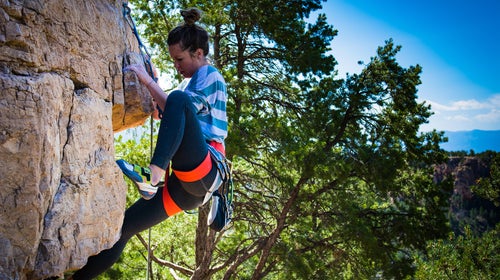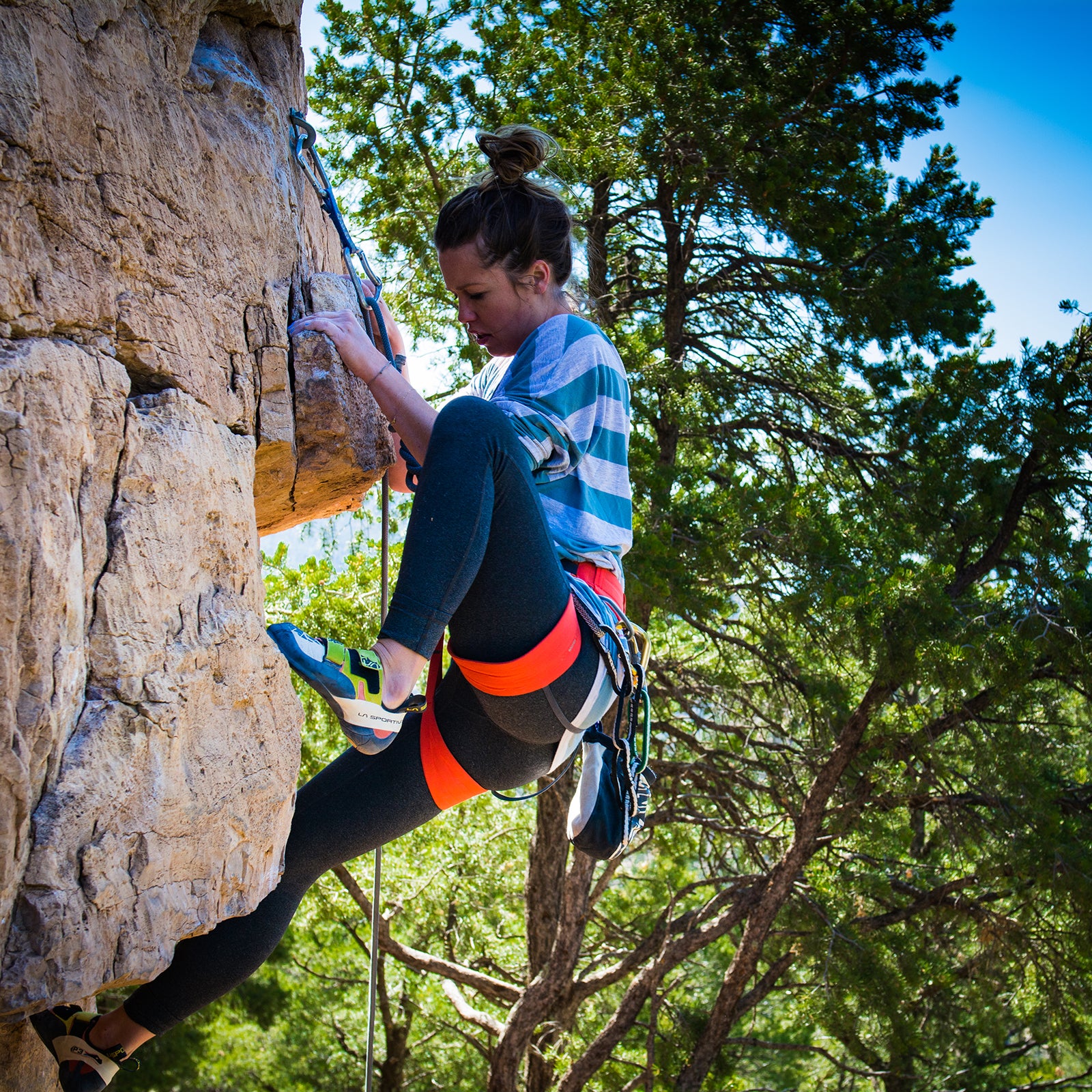Wearing��the right pair��of climbing shoes��is vital��when you’re high above the ground. But just because the shoe fits��doesn’t mean you should wear it. Depending on the type of climbing you’re doing—vertical big walls, trad routes, overhung sport, slabs, boulders—you may want a shoe that is flat or downturned, stiff or flexible, with a hefty midsole or a thin one. More likely, you’ll be looking for the ideal combination of several of those traits. Plus, of course,��your shoe can’t be so uncomfortable that your foot cramps.
That’s a lot to consider, so we recruited a team of��seven��testers to sample 14 models—12 of which came in both men’s and women’s versions—for a total of 26 shoes from six major brands. Ultimately, we��landed on our five��favorite pairs��for different climbing styles and disciplines.
How We Tested
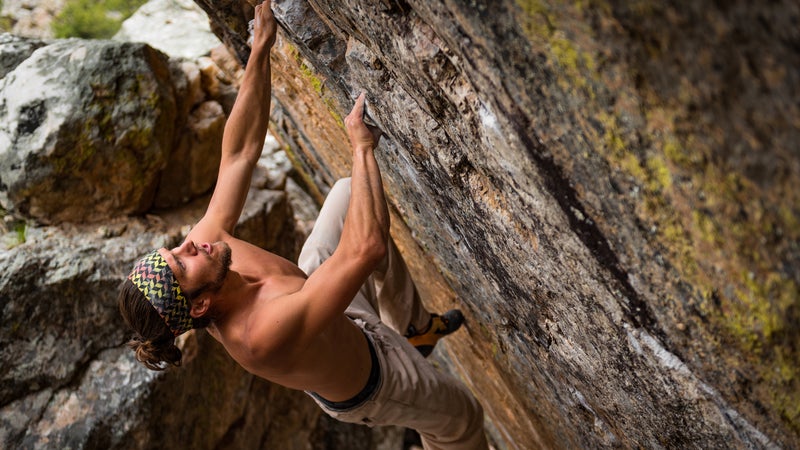
Our team of 11 testers—six��men and five women—included a climbing shoe resoler, a mountain guide, and a maker of climbing holds. We tested in and around Boulder, Colorado, on everything from boulders and slabs��to crack climbs and steep, overhung sport routes. After a few days of initial group testing, everyone grabbed several pairs of shoes specifically designed for their favorite discipline and went off on their own for five weeks of deeper evaluation.
Our female��testers all climbed in the women-specific version of each shoe whenever there was one available.��We found, however, that most women-specific designs were simply narrower or slightly thicker in the heel—that is, there were no true��performance or technological differences—and that testers’ fit preferences had more to do with foot shape than gender.
Best Big Wall and Crack Shoe
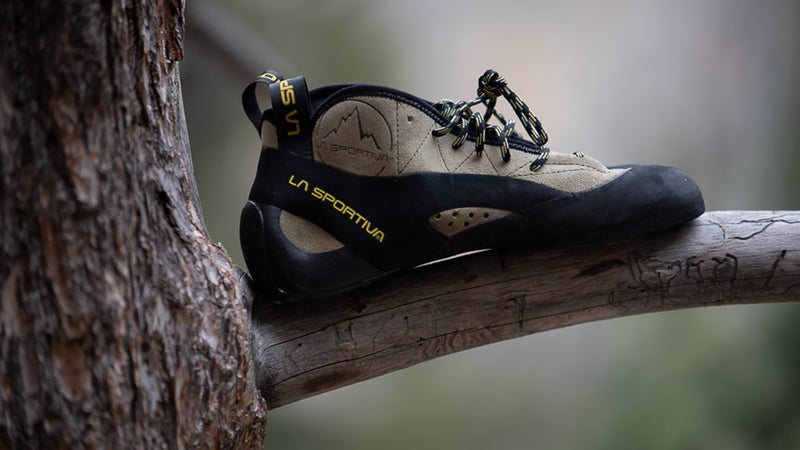
La Sportiva TC Pro ($190)
Specs: 8.75 ounces; semi-stiff
Pros: High performance;��relative comfort;��versatility
Cons: Not aggressive enough for overhanging routes; expensive
More than ten years after its release, lives on as one of the most favored and adaptable��climbing shoes on the market. Developed in collaboration with Tommy Caldwell early in his Dawn Wall project, this lace-up shoe��has a semi-stiff sole that provides reliable leverage on small footholds, ideal for vertical or just-off-vertical climbs with credit-card-thin edges. “This shoe loves granite!” one tester said after a day climbing on tiny, sharp crystals. The shoe’s flat, wide sole and padded��cuff also keep your feet secure and your ankles��(relatively) comfortable in cracks. The toe box is pointier than a lot of trad shoes, so it not only fits into small splitters��but also holds onto some overhung features, making it uniquely versatile. One tester, who took the shoes up several routes on the Diamond on Longs Peak, pointed out that the shoe shines on “routes that require a variety of techniques,” from hand jamming to face climbing. Still, several of our testers were happy to size down and take the TC Pro single-pitch sport climbing and bouldering, where they held their own. (One tester bouldered in the TC Pro on problems from V0 up to V8.)
Tech aside, we loved the TC Pro for its comfort. The mesh tongue breathes better than others made��with leather. And since the shoe��was made for big walls, it has a more relaxed fit that accommodates different foot shapes.��A handful of our testers sized up for a roomier fit��on long��routes��and said they were still able to stand on small nubs with control, despite the extra space.
That said, potential buyers should keep two things in mind about the TC Pro: it lacks enough downturn to lock onto steep or overhung routes as securely as a shoe built for that purpose, and it’s expensive, especially for a shoe that many climbers will beat up by jamming into cracks. Still, our testers liked the TC Pro better than its closest competitor, the Mid Eco, which has a similar design.��The Maestro has a slightly lower cut for more mobility in the ankle, but the toe box was a bit too wide to fit into the smallest cracks. Plus,��the TC Pro’s rubber felt stickier.
Best Bouldering Shoe
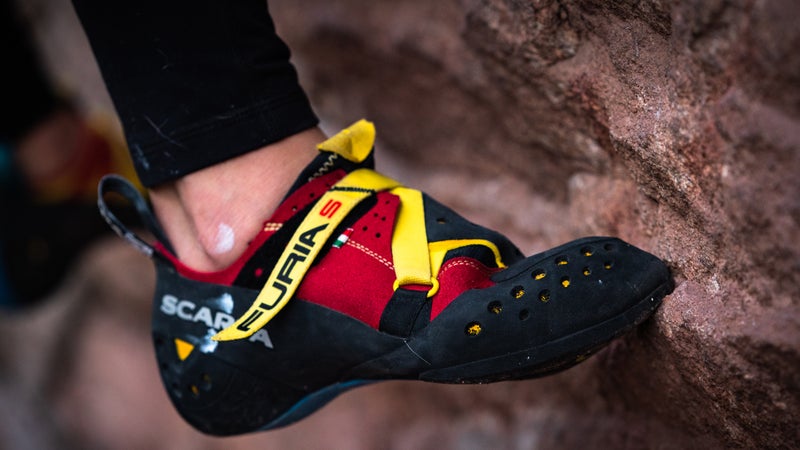
Scarpa Furia S ($195)
Specs: 7.76 ounces; soft
Pros: Sensitive;��snug fit
Cons: Minimal protection;��expensive
When it comes to bouldering, advanced climbers demand maximum rock feel and push-off power. Unfortunately, these things are often at odds.��Not so in the Furia S. Scarpa both softened its ultrasensitive bouldering shoe, the Furia, and added a one-millimeter midsole. The resulting ��allows you to better��feel detailed features of the rock, make precise toe placements, and generate power off small edges, all with an aggressive downturn and deep heel cup. The synthetic upper locks down on your foot with a Velcro strap, even if you have a wide, flat forefoot.
Across the board, our testers liked how sensitive felt on smeary moves and in steep terrain. However, while the shoes are flexible enough to pass muster on slab climbs, that’s not necessarily their forte due to the downturned shape that puts less surface area on flat rock. When it comes to this style of climbing, the shoe is best suited for someone with strong technique.��A��less advanced tester slipped while climbing a slab in the Furia S.
If you want a shoe like the Furia S but with a slightly thicker sole (one tester found the Furia too sensitive on sharp sandstone and limestone), look to the split-sole , which is more aggressive, with a performance fit, a pointy toe, and extra rubber on top that toe scums exceptionally well on steep, overhung boulders. Some folks also liked the as a beefier, less sensitive shoe that does more of the work with less feeling.
Best Steep Sport-Climbing Shoe
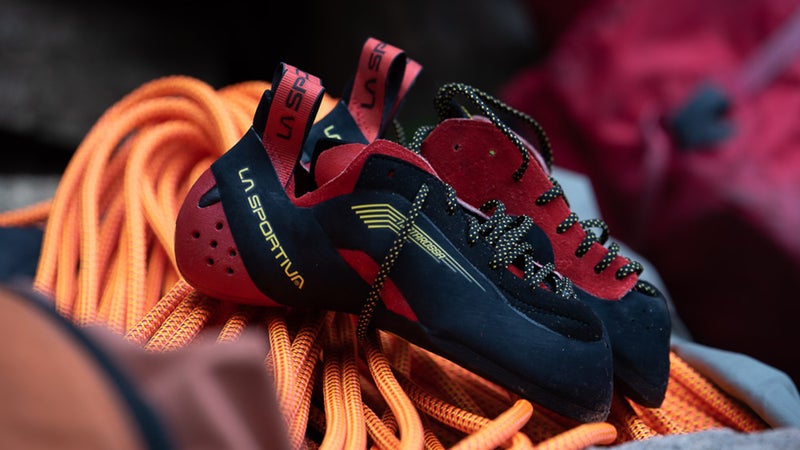
La Sportiva Testarossa ($199)
Specs: 8.9 ounces; medium stiff
Pros: Aggressive downturn; precision fit
Cons: Not an all-day-comfort shoe;��expensive
For more than a decade, has been among climbers’ favorites for steep, bouldery sport routes with technical edging and precise heel hooking. This year, for the first time since 2003, the shoe received��an update. The biggest change is in the heel, which now has thicker rubber reinforcements, so it holds its shape under pressure and practically vacuum-seals to the back of your foot. It��also retains the aggressive downturn and toe-length lace-up climbers have come to love for difficult sport routes. The upper is also��still a mix of leather and synthetic in targeted zones��for stretch on the tongue and in��lace holes without compromising rigidity on the sides and heel.
One of our more aggressive testers took these on a��5.11c trad lead that involved pulling up into a lie back, moving up through strenuous stemming in dihedrals, then transitioning onto several micro edges with desperate finger locks. He said the Testarossa gave him supreme confidence in��stepping over to gain the finger locks, and that “the heel fit perfect!”
The drawback of this shoe, as with any aggressively downturned model, is comfort. Expect to take a few weeks to break in the rubber rand and the synthetic sections running along the outer part of the upper, which don’t stretch as easily as leather. But we also tested far less comfortable shoes than the Testarossa that didn’t perform as well in terms of comfort, edging, and heel security. Climbers looking for an even stiffer option should reach for . The shoe’s toe and heel precision on steep moves made it a favorite for techy bouldering problems, but the��more��relaxed fit put it in a sport-climbing class worthy of longer routes.
Best Comfortable Trad-Climbing Shoe
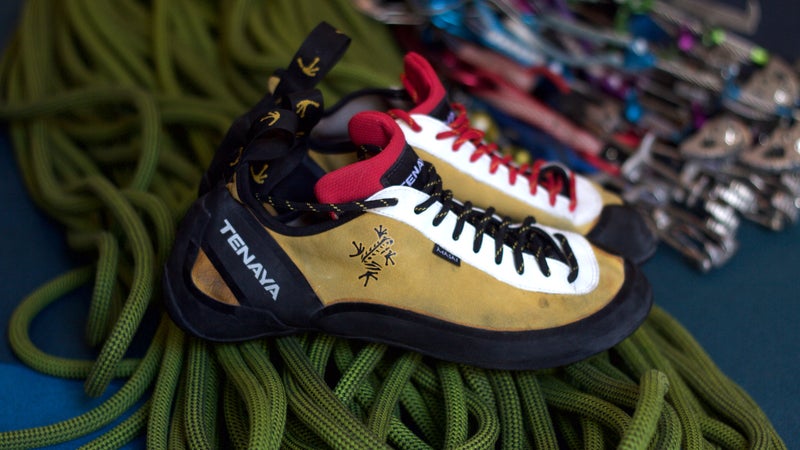
Tenaya Masai ($140)
Specs: 12 ounces; soft
Pros: Comfortable; soft, just enough power
Cons: Less power
When��you’re on a moderate multipitch trad route, carefully placing��gear and spending time at��belay stances,��wearing��painful shoes, and having��numb feet will��distract you from enjoying the experience. That’s why the relatively flat,��soft�� is a favorite for romping up easier terrain. The asymmetric toe box still concentrates��power onto your big toe for security on tiny holds, but your foot, rather than the shoe, does the bulk of the work—especially on very small edges. Expect weaker feet to tire after a while.
One trad-obsessed tester felt exceptionally solid locking these into cracks and climbing past sections where he’d normally have to stop and place gear. “It’s confidence-inspiring for such a soft shoe,” he said after running laps on 5.8+ routes in Eldorado Canyon. “And it’s fun to get so excited about a shoe that isn’t in the high-performance category but still climbs 5.10+ with solid edge hold.”
The ��is��a more entry-level, flat-lasted comfort shoe. It has a knit upper with a loose weave above the toe box for extra breathability and a microfiber hemp liner that minimizes chafing. The��rubber is molded, rather than cut, for a more anatomical fit. Testers reported the fit as��very big, so plan to go down at least a size or two.
Best Value Climbing Shoe
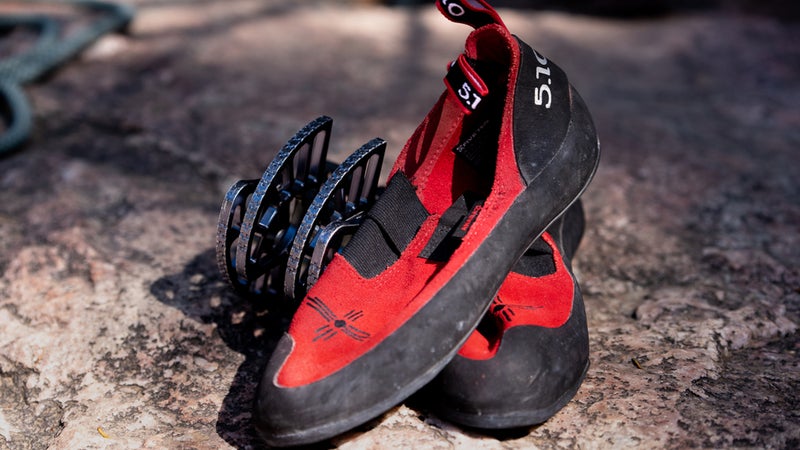
Five Ten Moccasym ($125)
Specs: 8.9 ounces
Pros: Affordable;��versatile; easy slip-on style; sticky
Cons: Less durable; lacks support for longer climbs; may dye your feet red
Talk about a shoe that punches up. relies on Five Ten’s ultrasticky Stealth Rubber to climb hard on any terrain despite an incredibly relaxed-fitting upper. It’s lace- and strap-free, with a simple elastic closure on the top of the foot to keep it just snug enough to stay on comfortably. These slip-ons wedge into cracks and conform to small footholds, while the flat sole provides ample surface area on slabs.
Along with the attractive price tag, testers of all levels loved the simplicity of these minimal shoes and the creativity that comes with letting your foot do the work, as opposed to relying on��a��shoe’s features. (A newer climber with less-conditioned feet may want a stiffer, more supportive shoe.) Here’s a fun, no-frills slipper��that can climb everything��but isn’t the best for anything.
Every tester did note��that the new Moccasyms dye your feet red after just a few climbs, and a few felt their limitations on overhung routes where you need an aggressive downturn to cling to the wall. It’s also not the most durable shoe: the stitching may fray��after a few months. ,��which retails for an affordable $89, also tested well in this category.
How to Fit Climbing Shoes
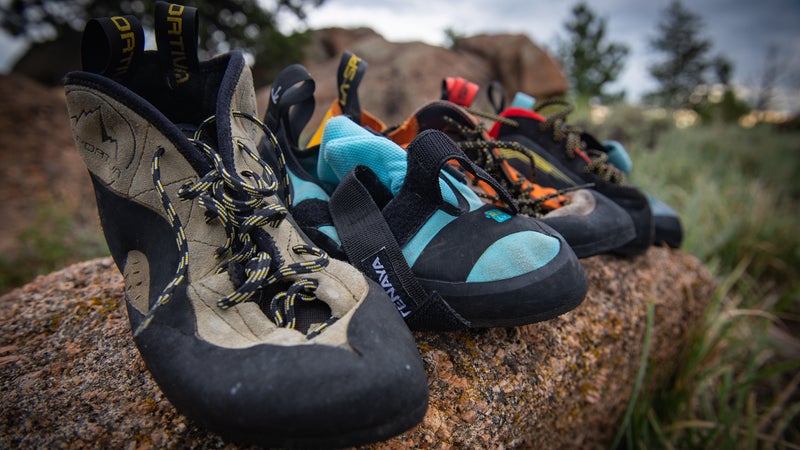
Trying on climbing shoes can make you feel like one of , jamming your toes into stiff, pointy leather instruments of torture that are apt to make you cry, cramp, or consider quitting before even getting started. Every brand and model fits and sizes differently, which makes picking the right shoe a daunting task. We’ve laid out the shoes with the best features, but finding the right fit is up to you—and, hopefully, an experienced employee at a gear shop.
For children and��new climbers, it’s most important to get a shoe that fits comfortably so you can enjoy the learning process��without too much pain. More advanced climbers��should��seek a performance fit that’s tighter and harder to walk in, with the priorities being��power transfer and control. Even if you’re going for comfort, make sure there’s no extra space in the toe box, heel cup, or arch. As a general rule of thumb, always go to a store to try them on.��Your climbing-��and street-shoe sizes will rarely be the same (some people go down anywhere from one to two full sizes for the former), and your foot shape will largely determine the kind of shoe that fits best.
How to Choose the Right Climbing Shoe
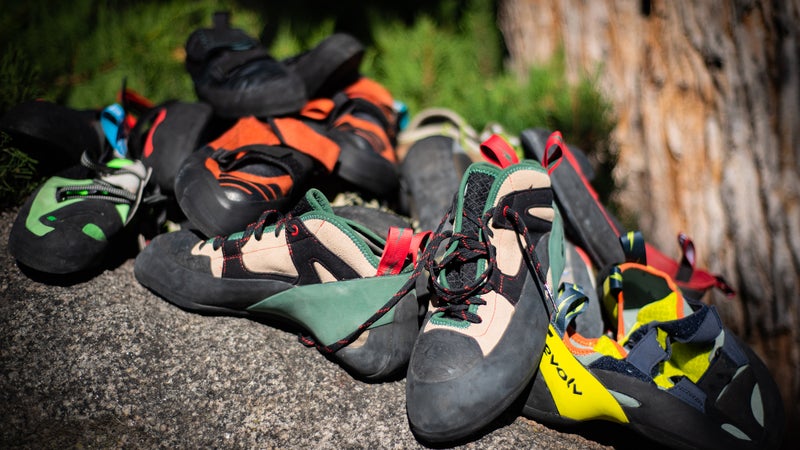
When picking the right shoe, unless you plan to buy a different model for each type of climbing, it’s best to start with the 80/20 rule. For example,��if you climb 80 percent steep sport routes and 20 percent boulder, start with a an aggressive��sport shoe. To choose, here are the terms and specs you should consider.
Shape
There are two main elements of climbing-shoe��shape to consider: downturn and asymmetry. Downturn refers to shoes that have an arcing shape, like the talon of an eagle, and are designed to grab holds on steep, overhanging climbs. Asymmetry refers to a lateral offset at the front of the shoe for more efficient power transfer to��your toes for the highest level of precision on tiny features. Shoes with a flat, symmetrical last are best suited for long trad routes or slabby climbing, because they’re comfortable—your toes won’t lose circulation—and because flat lasts smear better on smooth, off-vertical walls.
Stiffness
Stiffer shoes provide the best power on tiny micro edges, whereas softer shoes tend to feel more precise. However, supersoft shoes require more foot muscle. First-time climbers often��choose soft shoes, thinking they’re comfortable, but don’t have the foot strength to support their own weight without any structure. If you’re just starting out, opt for a flatter, more supportive model that will be versatile��and keep your foot muscles��happy��until your feet get stronger and you know enough about your own climbing to invest in something more specialized. Supersoft and downturned performance shoes are built for advanced climbers with conditioned feet.
Rubber
Shoe companies spend tons of time perfecting rubber compounds, and the technical details of those are beyond the scope of this review. But there is one major element of a shoe’s outsole you’ll want to pay attention to: how soft or hard the rubber is. Softer rubber is often stickier and conforms better��to small irregularities and crystals in the rock��but will wear out faster than harder rubber, which tends to last longer. For vertical climbing on edges,��many climbers swear��harder rubber is an advantage.
Sole
The thicker the outsole, the stiffer the shoe will be and the longer it’ll last before you need a resole. The thinner the outsole, the more sensitive and flexible the shoe will be and the sooner you’ll blow through the rubber. One is not necessarily better than the other—deciding is purely a matter of��what style of climbing you do and what kind of shoe you prefer.
Closure mechanism
Laces generally offer a more precise, dialed-in fit, but climbers with a wider feet often tend to prefer Velcro��(which is also easier to take on and off).
